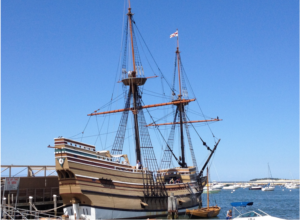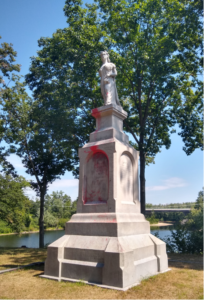
Early in November 1620, after a rough Atlantic crossing of about two months, an aging ship called Mayflower arrived in the coastal waters of what we today call Cape Cod Bay. By mid-December, the colonists had chosen a site they called Plymouth, which is about 40 miles south of the current city of Boston. Although English colonization had begun further south in the Chesapeake Bay area over a decade earlier – not to speak of even earlier Spanish and French efforts – the arrival of the Mayflower is frequently imagined by many in American mainstream society as the founding moment of the United States. Largely spurred and popularized by the Thanksgiving holiday, this founding myth all too often minimizes the impact of colonization on the indigenous peoples of the region; theirs is a history that hides in plain sight.
Before European colonization, Plymouth was an indigenous town called Patuxet – in fact the Wampanoag Indians often referred to Plymouth by that name in their interactions with the colonists. In 1605, just fifteen years prior, the famous French explorer and founder of the colony of New France, Samuel de Champlain, had traveled through the area and described Patuxet as a vibrant and prosperous community. When the English colonists arrived in 1620, however, they encountered a much different scene. Their journals described abandoned Native American houses (wetus), farm fields, and scattered human remains. The indigenous peoples in the Northeast then and now believe in the importance of burying their dead and the cultural significance of burial sites; thus, the English descriptions of stumbling over human bones and skulls indicates the extent of the catastrophe that overcame Patuxet. Throughout the early modern period, diseases from Afro-Eurasia were introduced and ripped through Native American communities across the Western Hemisphere with devastating impact. The outbreak of the pandemic must have been so calamitous that the Patuxet had been unable, or too scared, to bury their relations.
Arguably, the most central Native American player in the popular accounts of Plymouth is Tisquantum – better known as Squanto, a diminutive version of his name. As American elementary children learn early on, Tisquantum taught the English colonists how to farm and subsist in New England using Native crops and agricultural practices. He also taught English colonists to navigate southern New England’s dangerous shoals and waterways (he actually died during one of those missions in November 1622).
Tisquantum’s usefulness to the colonists is the stuff of children’s books and 3rd grade Thanksgiving performances, but his very usefulness to the colonists hints at a much larger and difficult story. How did Tisquantum learn English well enough to communicate with the colonists? The answer: His language acquisition is tied to one of colonial New England’s most central and hidden institutions – slavery. Tisquantum was among hundreds, maybe thousands, of Native Americans in the coastal northeast who had been captured and sold on the Atlantic slave markets before Plymouth Colony had been established. Tisquantum, through various contingencies, did the almost impossible: He made his way back to New England. This, however, was an unusual destiny for indigenous people captured during a slave raid, as most of them perished in the emerging Atlantic Slave Complex.
Slavery continued to have an impact after the establishment of English colonies in New England. Throughout their conflicts with Native Americans in the 17th century, the English sold thousands of indigenous prisoners of war into Atlantic slavery. At least 1,000 – maybe as many as 2,000 – were captured and sold during King Philip’s War, the brutal conflict that broke out between 1675 and 1678. Native Americans were also used as slaves within New England. After the Pequot War in the 1630s, New English colonial elites introduced several hundred Pequot war captives as servants into the colony. The debate about what to do, how to treat, and how to define these prisoners of war influenced the larger debate about the definition and implementation of slavery. Moreover, several Pequot prisoners were exchanged for enslaved people of African origin. In fact, the Massachusetts Bay Colony was the first English colony to legalize slavery in the 1640s. While people of African origin would play a central role in the later history of slavery in New England, the majority of those enslaved in the region throughout the 17th century were people of indigenous descent. Their bondage continued even with the increasing use of enslaved Africans as a significant portion of Native Americans of New England remained trapped in systems of slavery and servitude well into the 19th century.

Earlier this year, I wrote about the seal of the Commonwealth of Massachusetts and the questions it raises about the representation of Native Americans – certainly another legacy of colonization. The state motto on the flag – “by the sword we seek peace” – reveals yet another legacy hidden in plain sight and one that many residents in New England rarely consider. In the 17th and 18th centuries, a series of wars, military campaigns, and massacres enabled the dispossession and ethnic cleansing of indigenous peoples. Throughout various conflicts, New England authorities offered significant payments for Native American scalps including those of women and children. Moreover, two statues – one in Boscawen, New Hampshire (see picture on the right), the other in Haverhill, Massachusetts – have been erected to celebrate Hannah Duston, a captive who had killed and scalped ten Native Americans, six of them children, two women, and one old man. (Duston and her two allies first dispatched the one male of fighting age while he and the other nine slept).
As a result of the Black Lives Matter movement, the Duston statues have been a source for some controversy in recent months (as you can clearly see in the above picture) and have spurred debates about issues of race, representation, and the commemoration of an often violent and forgotten colonial past.
Another legacy of colonization is the myth in mainstream society, popularized in the 18th and 19th centuries, that states that Native Americans ‘vanished’ in New England. But here again, it was more about indigenous peoples “hiding in plain sight” of those who refused to see them. Despite over 400 years of colonization, wrought by the legacies of slavery, dispossession, poverty, racism, discrimination, and the termination of tribal status, indigenous peoples continue to make their homes all over the northeastern United Sates.
17,807 Total Views, 3 Views Today






